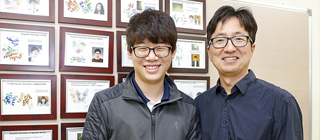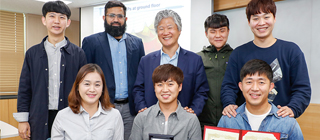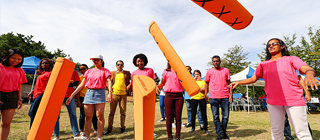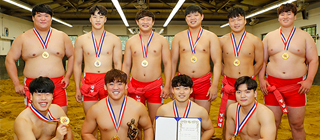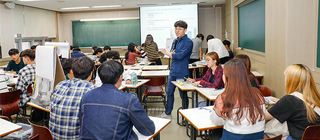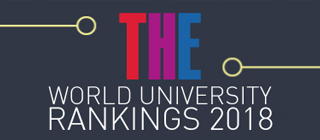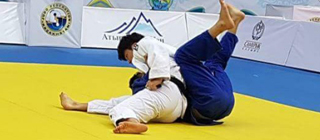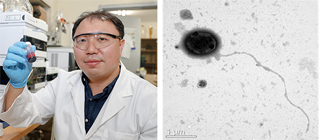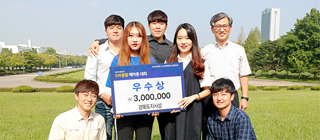-
School of Chemistry and Biochemistry Professor Park Hyun-ho’s research team investigates new platelet coagulation mechanism Listed in latest issue of the global academic journals ‘PNAS’ of the US National Academy of Sciences Research outcomes receive international attention since June... Recognized for world-class research [October 19, 2017] <YU School of Chemistry and Biochemistry Professor Park Hyun-ho’s research team became the first in the world to investigate the new mechanism for platelet coagulation within the blood at a molecular level> (Left to right: Kim Chang-min, Professor Park Hyun-ho) YU School of Chemistry and Biochemistry Professor Park Hyun-ho’s (42) research team became the first in the world to investigate the new mechanism for platelet coagulation within the blood at a molecular level. This research is receiving attention from academic circles as it is anticipated that it will provide a lead for the development of treatment, as well as understanding on thrombosis, which is a major cause for cardiovascular diseases such as myocardial infarction and cerebral infarction. When platelets in the blood coagulate at an abnormal status such as aging or wounds in blood vessels, it can cause blood clots. Localized accumulation of such blood clots can cause various types of thrombosis such as myocardial infarction, cerebral infarction, pulmonary emboliform, and deep vein thrombosis, as well as old-age related diseases. Therefore, anti-platelet agents are used to stop coagulation of platelets for the treatment and prevention of thrombosis. The best known anti-platelet agents are aspirin and clopidogrel. However, existing drugs have severe side effects such as bleeding, so the need for next-generation anti-platelet agents have been needed for quite a while. According to recent research results, GPlb (Glycoprotein lb), which is a platelet acceptor, activates for platelet coagulation only in non-ideal states of the blood vessel, and it also claimed that TRAF4 proteins that combine with GPlb is an important medium for delivering signals within the cell. Accordingly, preventing the combination of GPlb and TRAF4 can reduce side effects such as bleeding, and that it can be the ideal strategy for stopping platelet coagulation. The research team said, “We became the first to reveal the complex structure of TRAF4 and the platelet acceptor GPlb. A specific amino acid order of GPlb is joined with TRAF, and information on their combination at a molecular level will provide essential information for the development of next-generation anti-platelet drugs that stop the combination of TRAF4 and GPlb.” In addition, he said, “This study also revealed where TRAF4 bonds directly with the TGF-b acceptor, which is an acceptor that causes cancer, and it is therefore expected that it will provide important information in development targeted anti-cancer drugs that stops bonding of TRAF4 and TGF-b acceptor.” This study was carried out as the Korea Health Industry Development Institute’s ‘translational research support project’ and the National Research Foundation’s ‘platform technology development project’. Kim Chang-min (28, PhD course at the YU Graduate School of Chemistry and Biochemistry) as the first author and Advising Professor Park as the correspondence author. The research results was published in latest issue of the world-acclaimed academic journals <PNAS> (Proceedings of the National Academy of Sciences of the United States of America, impact factor 9IF) 9.65) published by the US National Academy of Sciences (NAS). In particular, the ‘Vessel Aging Control Research Center’ that is based on the TRAF4 target thrombosis treatment development research proposed by Professor Park’s research team based on the research outcomes was selected as a platform technology project supported by the National Research Foundation recently. Full-fledged research will begin for the development of next-generation anti-thrombosis drugs, and the Seoul National University College of Medicine and the Daegu Gyeongbuk Medical Innovation Foundation’s New Drug Development Support Center will participate as joint research institutes. Professor Park who led this research stated, “Our lab has been focusing on research on drugs and development of treatments through research on cell suicide and immunity and inflammation reactions from long ago. During our research on the structure and functions of TRAF family that is known to be a protein that acts as a medium for cell suicide and inflammation reactions, we found that only TRAF4 was involved more in platelet coagulation rather than typical functions.” He added, “We were able to achieve such great research outcomes by not hesitating and working together for along time in this new field together with the students at the lab.” Meanwhile, Professor Park’s research team has been receiving attention recently for their research outcomes such as publishing the research results on investigating the ‘DNA cutting phenomenon in cell suicide’ at a molecular level in June in <PNAS>. Professor Park and Mr. Kim Chang-min, who are the main authors of this study, were introduced in ‘Korea’s Stars’ provided by ‘BRIC’, which is a biology research information center, and has thus been recognized for their research capacities both domestically and internationally.
-
Department of Information and Communication Engineering Professor Park Yong-wan’s research team wins two awards at ‘IPIN 2017’ and ‘Best Poster Paper Award’ Received attention for demonstration of ‘new conceptual flank technology of smartphone-based indoor location system’ High utilization expected for general public and industries if performance is improved and becomes more compact [October 18, 2017] <Department of Information and Communication Engineering Professor Park Yong-wan’s research team prseented platform technologies that can commercialize indoor navigation at the ‘IPIN 2017’ held at Hokkaido University in Japan and is receiving attention from academic circles.> (From bottom left, Professor Heo Su-jeong, Sohn Hee-dong, Jung Seung-gu, from top left, Lee Chan-seok, Muhammad Usman Ali, Professor Park Yong-wan, Cho Young-rae, Kang Min-gyu) A research team of YU presented platform technologies that can commercialize indoor navigation, and is thus receiving attention from academic circles. At the ‘8th IPIN (Indoor Positioning and Indoor Navigation, hereinafter ’IPIN 2017’ held at Hokkaido University in Japan from September 16 to 2, the research team from YU received the ‘Best Poster Paper Award’ and was the ‘runner-up’ in the competition. The winner of the award was Department of Information and Communication Engineering Professor Park Yong-wan (57), ICT-based Smart Device Creative Talent Fostering Project Team Research Professor Heo Su-jeong (40), and Graduate School of Information and Communication Engineering students Muhammad Usman Ali (38, received PhD), Sohn Hee-dong (26, first time in master’s program), Kang Min-gyu (26, first time in master’s program), and undergraduate seniors Jung Seung-gu (25), Cho Young-rae (25) and Lee Chan-seok (25). ‘IPIN’ is the world’s only international conference joined by over 370 indoor positioning and navigation experts from approximately 40 countries around the world. Academic conferences and contests are held every year with the sponsorship of IEEE Computer Society that posses the highest number of organizations and members among the academic societies of the US IEEE. A total of 219 theses were submitted in the communication and computer sectors at the IPIN 2017 conference, and 165 papers were selected and presented. Professor Park Yong-wan’s research team received the honor of the ‘best poster paper award’ for 2017. In the IPIN 2017 competition, a total of 28 teams joined in a total of four tracks, and the YU research team was runner-up in track 1. The topic of Professor Park’s team was ‘Indoor Positioning Flak System using RSSI (Received Signal Strength Indication) Based Route Loss Model Map’. The research team proposed a path generation algorithm for pedestrians to easily find their way by accurately and quickly providing the current location as there has been a rapid increase in demand for indoor positioning services due to the development of smart devices. At the contest, a mission was given to walk along a 1km path for approximately 10 minutes going up and down the first and second floors of a building at Hokkaido University, and judges evaluated the accuracy of locations. The research team stated, “We developed a real-time indoor navigation system using the overlapping method of the RSSI mpa of the database and the RSSI value obtained by the smartphone.” The team added, “We received a great deal of attention as we have come to the stage right before systemization and commercialization by applying in various applications such as smartphones based on indoor flank research.” Recently, buildings are becoming massive as seen in many skyscrapers and shopping complexes, and underground spaces are also expanding due to the development of subways. Indoor navigation is judged to be a core technology of the future as it will be highly useful, and therefore, Professor Park’s research team’s research findings are receiving a great deal of attention. The research team joyfully said, “We were able to receive this award by paying attention to the vision of indoor positioning flanks and the roles of information and communication technologies and proceeded with research diligently since 2007.” They added, “The technology that we proposed is not applied only for indoor positioning. If technologies can be integrated to improve performance and gain more portability, its application can be expanded to technologies that help with new marketing strategies such as for shopping malls and exhibitions.”
-
YU Park Chung Hee School of Policy and Saemaul holds ‘Global Saemaul Chuseok Festival’ Over 200 participate including international students from over 40 countries and faculty and Korean students Experiences Korean culture through traditional folk games such as yutnori, jegichagi and tuho [September 29, 2017] <International students of the Park Chung Hee School of Policy and Saemaul playing yutnori at the ‘2017 Global Saemaul Chuseok Festival’> YU (President Sur Gil-soo) held a Chuseok event for international students studying in a country far from their own. The YU Park Chung Hee School of Policy and Saemaul (Dean Kim Gi-soo) held the ‘2017 Global Saemaul Chuseok Festival’. The Park Chung Hee School has been holding the ‘Global Saemaul Chuseok Festival’ annually since 2013 to enjoy Chuseok together with international students. This event, which was held at the YU Folk Village on the 29th five days before Korea’s biggest holiday of Chuseok, was joined by over 200 people including approximately 130 international students from over 40 countries at the Park Chung Hee School of Policy and Saemaul, as well as Korean students, professors and faculty. <International students at the Park Chung Hee School of Policy and Saemaul’ participating in the ‘2017 Global Saemaul Chuseok Festival’> Dean Kim Gi-soo who prepared for this event said, “Chuseok is Korea’s Thanksgiving. I hope that on this traditional holiday of Korea, international students who came from around the world will join professors, employees and students they have met in Korea to share delicious food, talk with each other, and spend a good time.” He added, “There are various performances and traditional folk games of Korea prepared for this event. I hope that everyone will enjoy them together to experience traditional Korean culture and make great memories.” <International students display the traditional clothes from various countries at the ‘2017 Global Saemaul Chuseok Festival’.> The festivities kicked off with international students performing samul-nori. They showed off their samul-nori skills that they trained for while studying in Korea and received huge responses from spectators. Also, international students showed off their traditional clothes from their home countries in a fashion show, and participated in traditional Korean folk games such as yutnori, jegichagi and tuho to gain a deeper understanding of Korean culture. They also participated together in arm-wrestling, relay races, and hula-hoop passing to enjoy the holidays of a foreign country. Saifun Nahar (40, YU Park Chung Hee School of Policy and Saemaul, Department of Public Policy and Leadership, 3rd term in master’s degree program) from Bangladesh who attended the Chuseok Festival said, “I have been very busy studying while in Korea. I want to spend today with my friends from around the world during Korea’s holiday and enjoy the festivities,” while adding, “I do not know much about traditional Korean games such as yutnori, but I want to take part in various games and experience Korean culture as much as I can.”
-
50 YU students volunteer in talent sharing at Yongcheon 1-ri, Yongseong-myeon, Gyeongsan As part of the ‘3rd Volunteer Day’, engage in wall painting, portraits, etc. A day of festivities together with the ‘Gyeongsan Happy Town’ event hosted by the City of Gyeongsan [September 23, 2017] <On the 23rd, YU students took part in talent-sharing volunteer activities at Yongcheon 1-ri, Yongseong-myeon, Gyeongsan> (YU College of Design & Art painting walls) In the hot weather of late September, a quiet rural town of Gyeongsan was filled with energy all day long with college students and volunteers. Approximately 50 YU students and volunteers visited Yongcheon 1-ri, Yongseong-myeon, Gyeongsan together with other volunteers on the 23rd for talent-sharing volunteer activities. This was planned out as part of the ‘YU Volunteer Day’ that celebrates its third anniversary this year. Ever since 2015, YU has been visiting towns in Gyeongsan to engage in talent-sharing volunteer activities. YU students who participated in the volunteer activities used their talents to paint portraits and walls. The Cheonma Cheer Team and dance club of YU put on performances as well, receiving great responses from residents. YU students also came to this town on the 16th, a week before the actual event, and spent all day painting walls. Despite the hot weather, they worked hard to brighten the mood of the town. All parts of the town that were touched by YU students became beautiful wall painted streets. Kim Eun-ha (20, YU School of Fine Arts Painting Major, sophomore) who participated in the wall-painting volunteer activities said, “As soon as I heard that they were recruiting volunteers for wall painting, I immediately decided to apply to make use of what I learned in my major and to volunteer.” She added, “It was hotter than I expected it to be and there was no shade so I sweat a lot, but as the wall paintings were completed, the town ambience brightened up, and the residents also enjoyed our work, so I felt a sense of accomplishment.” The volunteer activity was carried out together with the ‘Gyeongsan Happy Town’ event hosted by the City of Gyeongsan. This event, which was hosted by the Gyeongsan General Volunteer Center, was joined by residents, volunteers, as well as local college students from YU, Daegu Catholic University and Daekyeung University, and Sadong High School volunteers, Gyeongsan Jungang Hospital, and a traditional folk music and performance team. In addition to the wall paintings and portrait painting by YU students, there were other talent-sharing volunteer activities such as medical services, cosmetic services, nail art, etc., and delicious foods and performances from a traditional folk music and performance team to bring festivities to an otherwise quiet rural town. Shim Seung-hyeon (19, School of Fine Arts, freshman) who participated in the portrait volunteer activities said, “My major is not in portraits so I lack skills, but they enjoyed my work a lot so I was happy.” She added, “If I have the opportunity again next year, I will make sure to join again. I hope that more students will also take part next time.”
-
Victorious in team event of the ‘9th Guryeo Women’s Championship and National Collegiate Ssireum Championship’ Second victory in the season following victory in the National Ssireum Championship Conquers team and individual events in major tournaments this year [September 29, 2017] <The YU Ssireum Team won the team event at the 9th Guryeo Women’s Championship and National Collegiate Championship for the second victory of the season.> The YU Ssireum team (Coach Heo Yong) won the team event at the 9th Guryeon Women’s Championship and National Collegiate Championship held in Gurye, Jeonnam on the 22nd. With this win, the YU Ssireum team recorded their second victory of the season for team events in national collegiate tournaments. YU took the winner’s cup at the 47th National Ssireum Championship, which was the first tournament of the season, and also won the last tournament of the year, making 2017 YU Ssireum Team’s year. In the preliminaries, YU defeated Jeonju University 4:2 and ousted Dankook University 4:2 in the semi-finals, showing their unparalleled skills. In the finals, they made a dramatic victory by defeating Inha University 4:3. Though the YU Ssireum team was doing well this year, winning this tournament was questionable. Some of the main athletes were injured before the tournament and so it was impossible to compete with their regular roster, so YU was evaluated to be one of the weaker teams. However, once the tournament actually started, YU exhibited superior skills from the preliminary rounds and demonstrated the class of the best college ssireum team. Coach Heo Yong (right on photo), who has lead YU’s ssireum team to its golden age, said, “We were able to win as the athletes became one with the will to be victorious at all costs despite various situations that put them at a disadvantage. I would like to thank the captain Kwak Ho-chang, as well as the rest of the team.” He added, “Despite the school being in several hardships, the school is providing full support so that the athletes including the ssireum team can focus on training. We will continue to work hard to meet expectations.” Coach Heo Yong, who led YU to victory in the team event at this tournament won the Best Coach Award. This year, the YU Ssireum Team not only won the major team events, but also took victories in individual events, and is once again receiving attention as a powerhouse for college ssireum. At the ‘71st National Ssireum Championship’ held in July, Park Chan-joo (20, Department of Special Physical Education, freshman) won the college Jangsa-class and Jeon Do-eon (20, Department of Special Physical Education, sophomore) took first place in the Yongjang-class. At the 14th National Haksan Ssireum Championship held in April, Jung Yeon-min (22, Department of Special Physical Education, junior) was victorious in the Jangsa-class, as the YU Ssireum Team swept the sand boxes in both team and individual events.
-
During Professor Park No-geun’s class on ‘Steel Forging (Design Class)’, professor and student came up with an idea Developed ‘slag measurement’ technology, an old challenge of the steel industry Pursuing application of equipment at the site through industry-academic research together with POSCO, etc. [September 25, 2017] News was made as YU undergraduate students came up with an idea during class that led to a patent being registered with high values for industrial use. This was the fruit reaped after two years of passion and challenges from a professor and students. The patent registered was ‘Slag Thickness Measurement Device (Patent 10-1764894)’. This was devised during the second semester of 2015 so that the idea that was made during the ‘Steel Forging (Advisor Park No-geun)’, which is a design class for juniors in the School of Materials Science and Engineering, could be applied in industrial sites. The inventors for the patent are YU Professor of Materials Science and Engineering Park No-geun (36, left on photo), Joo Jae-bin (27) who was a senior at the time, Kim Hyeong-wook (27), Koo Jung-mo (27), and Koo Gwi-young (23) who were sophomores. These students who were undergraduates when the patent was first applied for (October 2015) are not working at metal-related companies, while some enrolled in graduate school. Joo Jae-bin, who is working at a company specializing in the manufacturing of special steels, said, “As an undergraduate, it was difficult to complete a patent application, complete CAD works, and apply for patents. In particular, the essence for the patent was on improving the process, but it was difficult to gain information on the process, so we had difficulties.” He added, “I think the countless meetings with the professor and students to perfect the idea led to such great results. My experience back then helped me greatly in finding a job specializing in the production of special steels.” Professor Park said, “The steel forging design class aims at understanding the chemical reactions between processes of steel refineries such as POSCO or Hyundai Steel, and to apply this to design processes or materials that can make it safer and have higher productivity in terms of engineering.” He added, “Applying engineering knowledge to design ideas that can be applied in an actual industrial site, and filling out patent applications as an undergraduate student will be a great asset in carrying out actual work.” <‘Steel Forging’ class of Professor of Materials Science and Engineering Park No-geun> It is expected that the patent registered will have significant value for use in actual industries. Slag refers to residue generated during the process of refining steel. Voices on the need to measure the quantity of slag in refineries were made dozens of years ago. But it was practically impossible to measure the amount of slag in high temperature work environments that reached up to 1,500 degrees. Therefore, operations were carried out depending on past experiences. Professor Park said, “Slag is a liquid ceramic made when oxygen mixes with molten metal. Ceramic materials should not be mixed with steel so it must be removed as much as possible. Therefore, it is very important to measure the slag thickness and volume.” He added, “During class, the students and I decided to apply the idea of measuring the height and volume of beer and foam in a glass to molten metal and slag. Starting with such idea, we resolved the problem occurring when measuring slag thickness at 1,500 degrees using the TRIZ (Theory of Solving Inventive Problems) and developed technologies that could be applied practically, and we were thus able to receive this patent.” The registered patent can be used by companies with blast furnaces such as POSCO and Hyundai Steel, and small factories with electric furnaces to adjust working conditions by measuring the amount of slag when making molten metal. Because slag and molten metal were discarded together in the past to remove slag, it had the weakness of having low recovery rates of molten metal. Using this patented technology to precisely measure the amount of slag, it will be possible to remove just the necessary amount of slag, and can thus improve the recovery rate of molten metal. Professor Park said, “Through the support of the YU PRIME program, I have been listening to the needs of industries and have been thinking about designs that could resolve the needs and be applied. This patent will be a ground-breaking technology that can remove slag, which has been an age-old challenge of the steel industry.” He added, “We are currently using this patent to discuss purchase condition development projects through industry-academic research with POSCO and small and medium enterprises in Pohang. We are also doing research to make a prototype for the idea and to apply it in actual facilities.”
-
World’s top two world university rankings together with QS Ranked 1,102 universities around the world including 27 Korean universities such as YU High scores in world university rankings including Leiden Ranking [September 7, 2017] THE World University Ranking 2018 Rank in Korea World Rank College Overall Score 1 74 Seoul National University 64.9 2 95 KAIST 60.9 3 111 Sungkyunkwan University 59.3 4 137 Pohang University of Science and Technology 57.3 5 201-250 UNIST 50.1 6 Yonsei University 50.0 7 Korea University 48.5 8 351-400 Hanyang University 41.0 9 GIST 40.3 10 401-500 Kyunghee University 39.7 11 Chung-Ang University 36.0 12 501-600 Ewha Womans University 33.9 13 University of Ulsan 32.9 14 Sejong University 31.6 15 Konkuk University 30.7 16 601-800 Pusan National University 29.3 17 Sogang University 27.6 18 Yeungnam University 23.8 19 Inha University 23.4 20 Chonbuk National University 22.9 21 Chonnam National University 22.7 22 Kyungpook National University 22.2 23 University of Seoul 21.5 24 801-1000 Ajou University 20.3 25 Seoul National University of Science and Technology 19.6 26 Chungnam National University 19.1 27 Hallym University 16.4 * Source : THE World University Ranking 2018 * Rank in Korea : is obtained by calculating score by index, not rank by the official announcement. YU (President Sur Gil-soo) was ranked 18th in Korea (601-800 in the world) in the British university ranking institute, ‘THE’ (Times Higher Education). On the 5th, THE announced its world university ranking results on 1,102 universities around the world. A total of 27 Korean universities were included such as YU, Seoul National University (74th) and KAIST (95th). In this ranking, Oxford University of England took first place in the world, followed by Cambridge University of England and the California Institute of Technology, Stanford University, and the Massachusetts Institute of Technology (MIT) from the United States for the top 5. THE, which was established in 1971, is an authoritative global university ranking institute together with the British QS (Quacquarelli Symonds) and has been announcing world university rankings since 2004. Its rankings are based on five indices such as educational conditions (30%), research achievements (30%), citations of theses (30%), internationalization (7.5%), and industry-academic cooperation (2.5%). Educational conditions are subdivided into five indices, research achievements into three, and internationalization into three. In particular, the world university rankings of THE applies strict standards and is globally acclaimed. Meanwhile, YU surprised the world by being ranked 37th in the world (based on top 10% thesis citation) and first in the world in the mathematics and computer science sector in the ‘2017 Leiden Rankings’ that was announced in May. YU was ranked in the top 50 in the world for three consecutive years in the mathematics and computer science sector in the Leiden Rankings that assesses global university rankings based on the quality of theses. Excluding YU there were no Korean universities ranked in the top 20 in all of the six fields announced by Leiden Rankings, thus demonstrating that YU’s research capacities are acknowledged around the world. YU President Sur Gil-soo said, “Our university has been continuously receiving good evaluations from world-acclaimed university ranking institutes,” and added, “We will continue to provide support so that our education and research levels can become of world-class levels.”
-
Wins the 2017 Kazakhstan Grand Prix Judo for the Disabled Wins all matches with ippon, showing unparalleled skill levels Following two championships in the single and group sectors of the ‘2017 Asia Judo Championships for the Disabled’ in May, another gold at an international tournament [September 13, 2017] <Kim Yun-ho (center) of YU Judo won the ‘2017 Kazakhstan Grand Prix Judo for the Disabled’ (-81kg division) to take gold.> Kim Yun-ho (21, Department of Special Physical Education, junior) of YU judo took the gold medal by winning the ‘2017 Kazakhstan Grand Prix Judo for the Disabled’ (-81kg division). He won a total of three gold medals in two international tournaments that he competed in this year, including a gold in the group tournament. <Kim Yun-ho (white) grapples his opponent from Kazakhstan in the finals of the ‘2017 Kazakhstan Grand Prix Judo for the Disabled’> Kim won gold by defeating all of his opponents with ippon in the –81kg division at the Grand Prix Judo for the Disabled at Kazakhstan from September 5 to 10. Kim also conquered the Asian stage at the ‘2017 Asia Judo Championships for the Disabled’ held at Tashkent, Uzbekistan in May by winning two golds in the individual and group tournaments. Meanwhile, despite having visual impairments, Kim is a highly skilled and promising athlete who won two general college tournaments, not tournaments for the disabled. After ceaseless persuasion from Coach Park Noh-shik of the national disabled judo team, Kim finally joined the national disabled team in April of this year. Since joining the national team, he won three gold medals in two international tournaments and brightened his prospects to earn a medal at the 2018 Asian Games for the Disabled and the 2020 Paralympics.
-
College of Medicine Professor Choi Hyeok-jae’s research team joint research with the Marine Biodiversity Institute of Korea Microorganism that produces useful antibiotics with excellent antibacterial and antibiosis functions Finds optimal culturing conditions of microorganisms containing expensive antibacterial substances... Green light for the marine bio industry [September 13, 2017] <Professor Choi Hyeok-jae of the College of Medicine who discovered a new marine microorganism that produces useful antibacterial substances> Upon culturing and analyzing marine microorganisms found in the sedimentary soil on the coastlines of Jeju, the Ministry of Oceans and Fisheries announced that it had confirmed that it contained prodigiosin, a substance with excellent antibacterial and antibiosis functions. The research team of Professor Choi Hyeok-jae (left on photo) of the YU College of Medicine and the research team of Dr. Grace Choi of the Marine Biodiversity Institute of Korea discovered a new marine microorganism while exploring the sedimentary soil of the coastal regions in Gimnyeong, Jeju in March of last year. This substance was named Mabikibacter ruber after the name of the Marine Biodiversity Institute of Korea. The discovery of this microorganism was introduced globally by being published in the world’s most authoritative academic journal in the microorganism taxonomy sector, ‘IJSEM’ (International Journal of Systematic and Evolutionary Microbiology) on August 25, 2017. Mabikibacter ruber is a word combining MABIK from the National Marine Biodiversity Institute of Korea and bacteria (bacter). ‘Ruber’, which means red in Latin, was added as it has a red color while being cultured. Professor Choi said, “This strain was found by coincidence from marine sediment specimens that students on vacation collected.” He added, “This research was possible thanks to the students who are always interested in the surrounding nature.” In order to check the biological structure and whether it contains useful materials, the research team cultured Mabikibacter ruber for seven months in a medium (liquid or solid compound with nutrients needed to culture microorganisms, plants, tissues and cells) and extracted the strings and conducted chemical analysis. They discovered that it contained prodigiosin, an antibiotic with a red color. Prodigiosin is widely used as an antibacterial and antibiotic substance, while being effective against malaria. It is also being used for developing treatment for pancreatic cancer. There were also recent reports that prodigiosin suppresses the growth of borellia bacteria that causes lyme disease (infectious disease caused by a tick biting a person and spreading the borellia pathogenic bacteria in the human body causing diseases in various organs. The early symptoms are fevers, but when it advances, it can cause encephalitis, arrhythmia, myocarditis, etc.). It is thus expected that its value as an antibiotic will grow in the future. <College of Medicine Professor Choi Hyeok-jae’s research team> Professor Choi’s research team said, “In this study, we succeeded in the isolation and purification of prodigiosin, which was known to be very difficult, thus confirming the structure of prodigiosin that produces Mabikibacter ruber.” He added, “This substance is a prodigiosin derivative not available in the market, so its economic potential is enormous.” The research team found the optimal culturing conditions that can produce prodigiosin in mass amounts through the process of culturing Mabikibacter ruber, and is planning to develop mass production technologies through this. Currently, prodigiosin-type antibiotics are being traded at high prices in the pharmaceutical markets, and in the event that mass production technologies are developed by the research team and the technologies are transferred to relevant industry, it is expected to contribute significantly to the activation of the marine bio industry.
-
Proposed ‘smart rainroof bus’ and received good reviews for its ‘creativity, marketability, realistic possibility’ Improved capacities in majors through ‘C++ Camp’, ‘Embedded Camp’ and academic club activities during vacation Professors provided instructions at camps and clubs to raise satisfaction levels and capacities of students [September 12, 2017] <The YU Department of Information and Communication Engineering HOWTO Team awarded at the ‘4th Korean SW Convergence Hackathon Contest’.> (back row, left to right: Yang Hyun-gyu, Lee Yun-ho, Professor Kim Young-tak, front row left to right: Heo Jin-woo, Kim Ji-hyeon, Jang Ji-mo, Ha Dong-soo) Students from the YU Department of Information and Communication were awarded at the ‘4th Korean SW Conversion Hackathon Contest’. This contest, which is the nation’s largest SW convergence technology contest, was held for three days at the Kyungpook National University Global Plaza from the 31st of last month to September 2 hosted by the Ministry of Science and ICT and the National IT Promotion Agency. Hackathon is a word combining the two words of ‘hacking’ and ‘marathon’. Like a marathon, participants come up with ideas, engage in programming, and build creative works without resting for 42.195 hours. This contest was comprised of the three themes of ‘free topic’, ‘development of services for improving common life’, and utilization of public-data based water resources and development of flood prevention services’. A total of 296 people in 60 teams announced their unique ideas. In result, the ‘HOWTO’ team comprised of Heo Jin-woo (25), who graduated, and juniors Ha Dong-soo (24), Yang Hyun-gyu (24), Lee Yun-ho (22), Jang Ji-mo (22), and Kim Ji-hyun (20) of the YU Department of Information and Communication Engineering was awarded in the free topic sector. The idea proposed by the HOWTO team was the ‘Smart Rainroof Bus’. They designed functions in which wipers would activate automatically and a rain roof would operate automatically when opening and closing doors for passengers by detecting rain while the bus is operating. Their idea received good reviews in terms of creativity, marketability and realistic possibility. Team leader of HOWTO Heo Jin-woo said, “We thought about ways to improve user convenience by integrating IoT in buses that we use every day, and came up with this unique idea during our brainstorming session.” All of the students that were awarded were under the YU Department of Information and Communication Engineering’s HOWTO club (Advisor Kim Young-tak). The network programming academic club ‘HOWTO’ started in 2000 with 11 students, and gained popularity now having over 100 students participating in the club activities. They all said in unison, “The major capacity improvement camp operated during summer break by the department helped a lot in making it possible to come up with ideas, program, and configure prototypes in a short period of three days.” In addition to the regular curriculum, the students of the YU Department of Information and Communication participated in the ‘C++ Camp’ and ‘Embedded Camp’ during breaks to learn programming languages. Based on this, they applied it in hardware and improved their capacities through 3-4 week concentrated learning sessions. Despite these classes not being part of the regular curriculum, professors instructed the students to enhance student satisfaction levels, while also helping them to improve their capacities in their majors. Department of Information and Communication Engineering Professor Kim Young-tak, who is the advisor of the HOWTO club said, “It might be a bit difficult to follow classes in majors in the beginning,” and added, “If students participate in camps and programs on their majors during their vacation or through academic clubs aside from regular classes, it will help them gain more interest in studying their major.”
